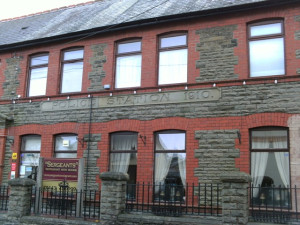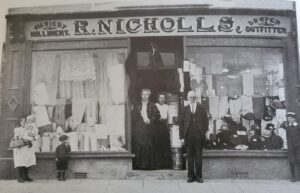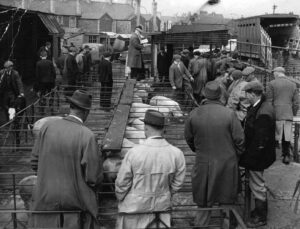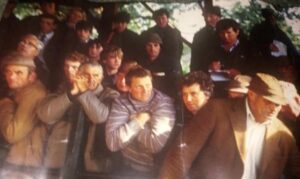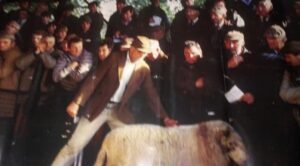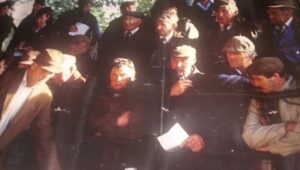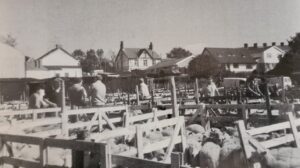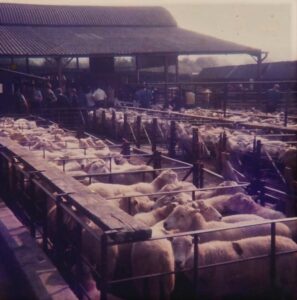Historic Nelson
- Nelson
- Llanfabon
- Police Station
- Bottle factory
- Old Businesses
- Green acres
- Cattle Market
Ffos y Gerddinen
At the end of the 18 Th Century the area was called “Ffos y Gerddinen”. The English translation means bog or marshy ground of the rowan tree. In 1800 it is believed by many that Lord Nelson and Lady Hamilton visited Ffos y Gerddinen, enroute from Cardiff to Merthyr, and that they stayed the night in the Inn.
The Inn was subsequently named the Lord Nelson Inn and later the village was also re- named Nelson. This cannot be proven as a certain fact, but it is accepted to be true.
Population increase
During the 19th Century the village began to grow and the arrival of the railway and the local Llancaich colliery (see colliery section) provided employment and the need for more housing and services for the growing population.
In the railways section of this website there is more detailed information about the Railways that served the village.
By the start of the 20th Century the population of Nelson and district had increased almost ten fold to over 4,000 residents compared to just over 400, one hundred years earlier.
There have been many activities in the village over the years and I found this article Foot race about to start from opposite the old Royal Oak, part of the report is below dated November 9th 1895
Llanfabon
Nelson is in the Parish of Llanfabon and there are records of Llechwen Hall, a privately owned Country House dating back to the 17th Century. It is now an excellent 20 bedroom hotel that attracts tourists to the area.
The Parish of Llanfabon is comprised of two churches:
The Parish Church is situated at Llanfabon and is dedicated to St Mabon. The Daughter Church is situated in Nelson and is dedicated to St John Baptist.
St Mabon’s: Llanfabon
The original church would have been a simple wooden structure that has left no remains after 1500 years. There is mention in the Vatican Archives of the rebuilding of the church by the Earl of Hereford in the eleventh century.
By 1836, this building had fallen into disrepair and the then Rector appealed to the Church Building Society requesting grants for a programme of restoration. This appears not to have been successful.
In 1846, it was decided to demolish the medieval building and rebuild. The architect was John Pritchard, who was later to restore Llandaff Cathedral.
How Llanfabon was described in 1833
“LLANVABON, a parish in the hundred of CAERPHILLY, county of GLAMORGAN, SOUTH WALES, 9 miles (S. S. E.) from Merthyr-Tydvil, containing 853 inhabitants. This parish comprises a surface of about five thousand acres, in general mountainous : it is bounded on the west by the river Taf, and on the east by the Romney : the soil consists of gravelly clay and peat. A colliery belonging to Sir C. Smith, Bart., from which a tram-road communicates with the Glamorganshire canal, affords employment to about twenty men. The parish is intersected by the road from Cardiff to Merthyr, which passes about two miles and a half westward from the church, and by the Glamorganshire canal, on the banks of which, within its limits, is situated the Navigation House, where this important line of communication is joined by the Aberdare canal, and by the tram-road from Merthyr-Tydvil: at this point of junction is a spacious quay. The living is consolidated with the vicarage of Eglwysilan, in the archdeaconry and diocese of Llandaf. The church is dedicated to St. Mabon. There are two places of worship for Welsh Calvinistic Methodists, and one for Wesleyan Methodists. James Thomas, in 1730, gave by will a rent-charge of £2 for the benefit of the poor of this parish. The average annual expenditure for the maintenance of the poor is £213. 19.” ( A Topographical Dictionary of Wales by Samuel Lewis 1833)
sourced from Genuki
Population of the Llanfabon Parish in the early years
| 1841 – 1,449 | 1851 – 1,925 | 1861 – 2,360 | 1871 – 2,263 | 1881 – 2,660 | 1891 – 3,037 |
Sourced from Census records and Genuki
Police Station
The building is swathed in history. In September 1910, a Llandaff builder named Mr. S. Shail put forward a tender to build the police station for the princely sum of £1895. The building was completed and ready for occupation by June 1911 and Sergeant Walter Kelland, Nelson’s first sergeant moved in with his family.
It is now an excellent restaurant called “Sergeants”,
St John’s: High Street Nelson
Due to the expansion of the village of Nelson during the mid 19th century the population of Llanfabon was a mere 475 in 1801, but by 1901 it had increased to 4,035 – it was decided to build a daughter church closer to the new population.
At the time, this would have been described as a Chapel of ease to Llanfabon. The original church of St John Baptist was completed in 1888. By the end of the century the original church was considered to be too small. In 1904 it was extended and a tower was added.
Nelson Bottle factory,High street Nelson.
During the middle of the 19 th century there was a bottling factory by the name of Peters and Osborne operating out of a small factory on the High Street…we have some photographs of the bottles that were sent from the factory to different locations throughout the UK. During 1905 the company changed from Peters and Osborne to E M Peters(courtesy of Robert Amos)
Above we also have acquired a receipt dated September 12th 1910 that was sent to a customer.
Pictured below is an early photograph of Commercial Street in Nelson…You can see the letters MCA in the top of the building that now holds the Chinese takeaway..opposite Barclays bank,below you can see the shop that sold China and Pottery.
A pot from Nelson possibly from the shop in the picture above
Two More souvenirs from the past below
Former Businesses found in Nelson
A list old businesses that used to thrive in Nelson. The list will not include all former businesses but hopefully a selection to bring back memories.
Austins grocery Shop, High Street/Shingrig Road ( the square)
Dispensing Chemist ( Hadyn Parry) 33 Commercial Street
East Glam Motors Ltd, Brooklands Garage, Shingrig Road
E A Parr Bookseller
Electric Shop (J Davies) 14 Commercial Street
E M Coombes Baker, Commercial Street
Express Cafe Franchi The Square
G Kensole, Architech and surveyor
Griffin E. Boot and Shoe maker, Llancaiach
India and China Tea Company, Commercial Street.
Ira Meredith, Barber shop, High Street,The Square
J R Hughes, Meat Purveyor, 9, High Street
J & T Evans Bakers and Confectioners High Street
Park Stores ( O.J. Whiteman) Shingrig Road
Preece Brothers Blacksmiths
Price Brothers Blacksmiths
R Nicholls, Drapers and Millinery, Commercial Street
Ricci Brothers Temperance Bar( cafe) Commercial Street.
Tambinis Cafe (Franco Tambini) Commercial Street
T Edwards Bookseller and Stationer
T H Farrow and Son, Records,Televisions and Radio, High Street
Green Acres Housing Estate
During the 1980’s there was great concern in Nelson amongst the residents of the relatively new houses above the village in the Green acres and the Avril estates. Below we are fortunate to get a report and some pictures from that worrying time…Robert Amos who supplied this item for the web site is actually pictured in the photographs doing the repair work.
The Sewage Works on Mabon Road
I am looking for information about this sewage plant that was once on the entrance to Nelson, but here are some photographs of it after it was closed (courtesy of Robert Amos)
Nelson Cattle Market
Cattle market trading March 1964
Market day making bids
Photographs of the Cattle market site behind Dynevor Terrace.(R Amos collection) date 1999
Below we see two pictures of the site being cleared ready for new homes
The Market site in 2013


